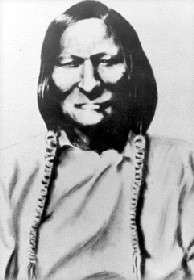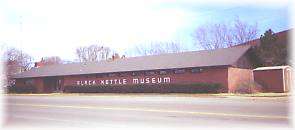
Posted on 01/22/2008 8:41:46 AM PST by drzz

"I just read in an Indian depredation claim I copied from the National Archives last summer that Black Kettle was understood by everyone in 1868 as being a spy for the raiding Indians. He would profess peace and all the time he was gathering information he would later share with the Dog Soldiers to assist them in their raids, etc." Dr. Jeff Broome, author of the very important book "Dog Soldier Justice", the most accurate depiction of the Indian massacres of 1868
"Some of the raiders came from Black Kettle's camp. As was the case on numerous previous occasions, his village was open to terrorists. When the raiders returned, Black Kettle made a run south of the Arkansas River." Famous Old West historian Gregory Michno, author of "Lakota Noon" and recently "A Fate Worse than Death" which relates the captivities under Black Kettle's reign
"... 158 men murdered, sixteen wounded and forty-one scalped. 3 scouts were killed, 14 women outraged, 1 man was captured, 4 women and 24 children were carried off." Chronicles of Oklahoma, events of the summer 1868
________________
The propaganda: "As white settlers poured into the west during the nineteenth century, many famous Indian chiefs fought to stop them, including Sitting Bull, Crazy Horse, and Geronimo. But one great Cheyenne chief, Black Kettle, understood that the whites could not be stopped. To save his people, he worked unceasingly to establish peace and avoid bloodshed. Yet despite his heroic efforts, the Cheyennes were repeatedly betrayed and would become the victims of two notorious massacres, the second of which cost Black Kettle his life."
This is how Thomas Hatch's hagiography of Cheyenne Chief Black Kettle, "The Chief who sought peace but found war", began. Do facts support this divine portrait? No. Not at all. From the events preceding the Sand Creek massacre to the Battle of the Washita, Black Kettle has never ceased to train and harbor terrorists. He also used to capture women and children who were gang raped and eventually murderded or sold to Mexicans. On the "Battle of the Washita" section of custerwest.org, you can look at the evidence prior to the fight of 1868. Black Kettle's headmen were leading the raids and took back to their camp numerous White hostages. The same massacres happened in 1864, prior to Chivington's attack at Sand Creek.
 ____
____
Little Rock, member of Black Kettle's village, interview, August 19, 1868: "The Cheyennes numbered about 200; nearly all the young men in the village went (…) The two Indians had outraged the woman before they brought her to the camp. (…) Big Head’s son knocked (an isolated white man) down with a club. (…) Soon after they killed a white man, and close by, a woman (…) After they had proceeded some distance up thr Saline, the party divided, the majority going north toward thr settlements on the Solomon (…) Another small party returned to Black Kettle’s village, from which party I got this information.”
____
There is absolutely NO evidence to support the claim that Black Kettle was peaceful or innocent. No one of his actions supported this idea. The Cheyenne chief used to exterminate settlers, abduct hostages and then ask for peace before the winter season. Evidence of his guiltness are overwhelming, and even supported by the chief's own claims.
However, as of today, Black Kettle is virtually praised by the entire nation. The National Park Service named a museum after him on the Washita Battlefield. Worse, the chief gained the posthumous title of "Peace Chief". Custer historians, as well as countless authors and filmmakers, tried every tactic possible to say that the Chief was not responsible for the hostages he was holding in his village. It was said that in Indian customs, welcoming warriors who had just slaughtered civilians wasn't a proof of complicity. ____
Edmund Guerrier, mix-blood civilian: "I was with the Cheyenne Indians at the time of the massacre of the Solomon and Saline Rivers, in Kansas, the early part or middle of last August, and I was living at this time with Little Rock's band (Little Rock and Black Kettle led the same band). The war party (of 200 Cheyennes and 4 Arapahoes) who started for the Solomon was composed of young men of Little Rock's, Black Kettle's (all from Black Kettle's village), Medicine Arrow's and Bull Bear's bands (...) Red Nose, and The Man Who Breaks The Marrow Bones, (Ho-eh-a-mo-a-ha) were the two leaders of the massacre; the former belonged to the Dog Soldiers, and the latter to Black Kettle's band."
____ 
This is where we are today. Raping, abducting, harboring terrorists isn't a crime as long as it is done by Cheyennes or any Indian warriors or chief. Black Kettle gained the Gandhi title and American historians whitewashed his bloody record without respect for historical truth.
In his book "The Battle of the Washita" (1970), Stan Hoig nicknamed the chapter of Indian depredations : "In Search of an Enemy". This is a typical semantic form used by those who think that terror victims are more responsible of their death that the terrorists who killed them. By pretending that the US army was happy to see Cheyennes murdering civilians in Kansas, Hoig puts the responsability of the war on American shoulders.
Pure academic fraud.
Worse, Hoig put on his fourth cover that the Cheyennes were not at war, despite the fact that an entire chapter is relating to the massacres that they commited. Again, this is pure propaganda.
____
General Sherman: "Americans cannot be humbugged into the belief that Black Kettle's camp was friendly with its captive women and children, its herds of stolen horses and its stolen mail, arms, powder, etc., trophies of war."
____
In "Washita" (2004), Historian Jerome Greene relates the "Summer depredations" in an entire chapter, quoting several witnesses who explicitely said that Black Kettle was involved in the massacres. Little Rock, of Black Kettle's tribe, even described in an interview the precise crimes that were commited. However, Greene continues to praise Black Kettle through the book, put the Cheyenne chief with the "peaceful tribes" and put the massacre on the shoulders of a few "young men" (the "young men" argument, which doesn't mean anything, is always used to whitewash an Indian bloody record). Of course, Greene also manages to make us believe that Black Kettle wasn't holding hostages (lie) and wasn't responsible of anything (the naive, innocent Cheyenne was not aware that his village was a terror base!).
These are lies, once again.
 ____
____
Clara Blinn, 19 years old, Black Kettle's hostage (letter written in captivity, November 7, 1868, before the Cheyennes shot her and smashed her baby against a tree): “Kind Friends, whoever you may be: I thank you for your kindness to me and my child. You want me to let you know my wishes. (...) If it is not far from their camp, and you are not afraid to come, I pray that you will try. They tell me as near as I can understand, they expect traders to come and they will sell us to them. Can you find out by this man and let me know if it is white men? If it is Mexicans, I am afraid they would sell us into slavery in Mexico.
____
But the propaganda goes on. Thomas Hatch praised Black Kettle and sang the "young men" song all over again. In 2007, Richard Hardorff called Black Kettle "the best friend the Whites had ever had" and didn't pay attention to the Indian depredations or the White hostages.
The song of the peaceful chief goes on, while history still waits in backstage. Dr. Broome's book on Indian depredations was praised and used by the Washita Battlefield, but no one dared to put the record straight and definitely stop to name a museum after a man who had so much blood on his hands.
- White hostage Clara Blinn's name is used as a trademark by a Cheyenne art gallery, not far from the spot when she was starving, probably gang raped and eventually murdered with her baby (watch the video beside). Black Kettle is however honored by the US National Park Service with a museum and constant praises (and the title of "Peace Chief"). -
Who will speak out to defend the victims?
 (Clara Blinn, 19 years old, murdered by Black Kettle's Cheyennes during Custer's Battle of the Washita, November 27, 1868. The Cheyennes smashed her son William against a tree. Both bodies were scalped and mutilated).
(Clara Blinn, 19 years old, murdered by Black Kettle's Cheyennes during Custer's Battle of the Washita, November 27, 1868. The Cheyennes smashed her son William against a tree. Both bodies were scalped and mutilated).
While my brother was working construction in Montana, one of the Indian construction workers said, “If it wasn’t for the white man, I would be riding the plains on my horse now instead of this.” Brother had to remind him that there were no horses in America before the white man. They don’t know their own history.
People tend to forget two things about the Washita: [1] Custer FOLLOWED a trail left by Indian raiders that went straight to Black Kettle’s village, and [2] Items stolen from settlers during the Indian raids were found in Black Kettle’s village.

PeterPrinciple you seem to think the white man gave them those horses. Which is not the case. The horses where introduced to the usa back in the 16th century. Some of the horses escaped into the wilderness and bred.Which where then aquired by the indians. But your co-worker is correct in the sense if it wasn’t for the whiteman and their greed he would be riding free on the plains.
PeterPrinciple you seem to think the white man gave them those horses. Which is not the case. The horses where introduced to the usa back in the 16th century. Some of the horses escaped into the wilderness and bred.Which where then aquired by the indians. But your co-worker is correct in the sense if it wasn’t for the whiteman and their greed he would be riding free on the plains.
Disclaimer: Opinions posted on Free Republic are those of the individual posters and do not necessarily represent the opinion of Free Republic or its management. All materials posted herein are protected by copyright law and the exemption for fair use of copyrighted works.